5 authentic Thai recipes anyone can tackle at home
Check out these dishes from "Kin Thai."
Thai cooking can be done at home with authentic ingredients and techniques -- and cookbook author John Chantarasak shared his method to do just that.
The half British, half Thai chef who studied Thai cooking in Bangkok shared traditional recipes with "GMA" for Asian American Native Hawaiian Pacific Islander heritage month, from his debut cookbook "Kin Thai."
"I feel very honoured to be able to cook the food I love from Thailand, but with my own interpretation using my knowledge of local, seasonal Western -- particularly British -- ingredients," Chantarasak said. "I always try to respect the origins of the dishes I create, and hopefully people enjoy trying familiar dishes from Thailand that are cooked with a slightly altered mindset."
Chantarasak said he tackles a "majority of the common issues people ask me about" in his new book by distilling his "years of knowledge cooking Thai cuisine into digestible bites."
"Don't be afraid to try something new and to make mistakes, we only really learn to grow as a cook from the mistakes we make in cooking," he said, for those who may be new to tackling the cuisine.
Check out his full recipes below.
Sweetheart Cabbage, Roast Chicken and Chilli Jam Salad: Yum Galam Bplee
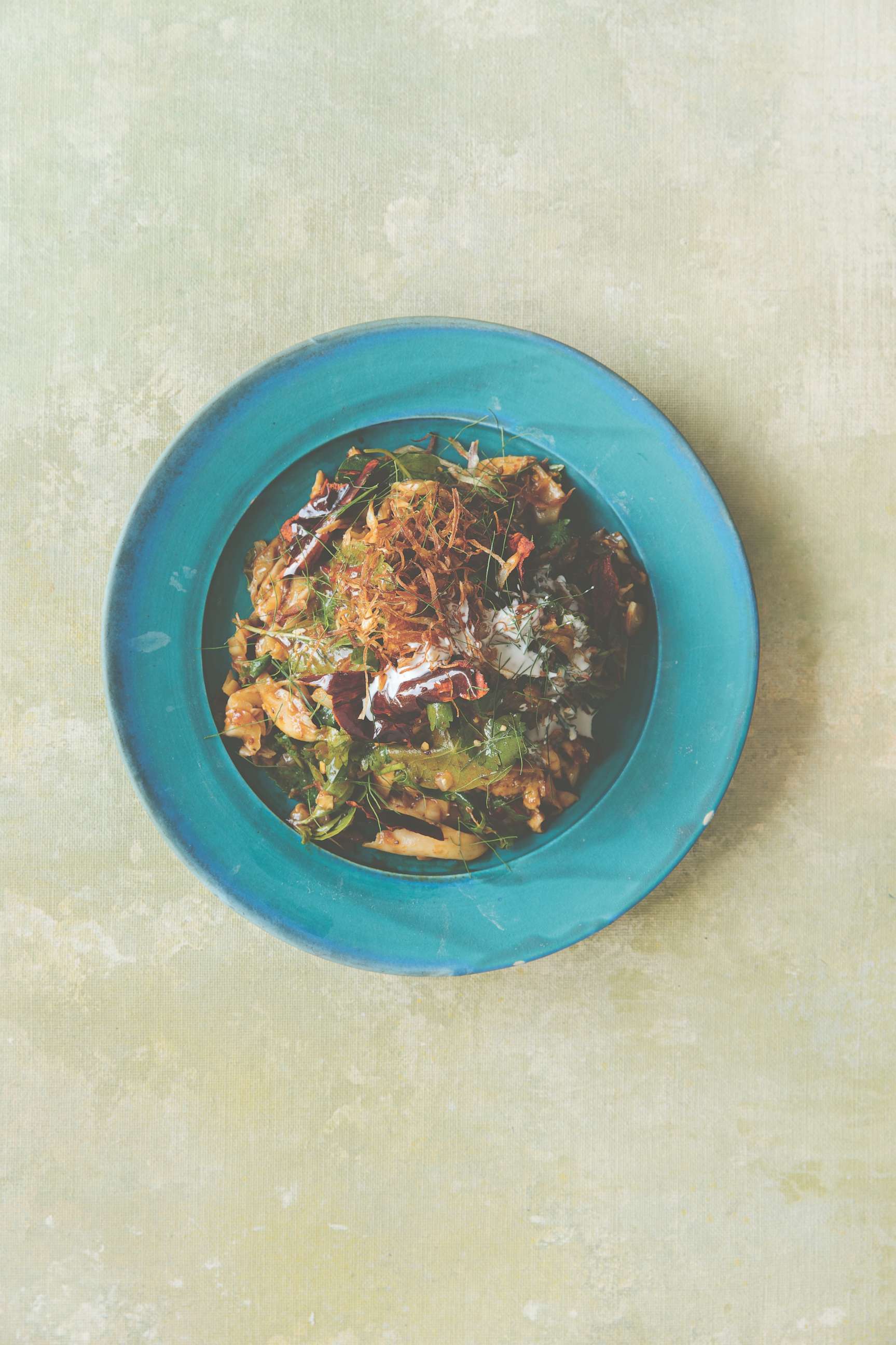
Serves: 2
"This recipe came about when I was thinking about an alternative to banana blossom salad -- yum hua plee. I find banana blossoms have a gentle flavor, not too dissimilar to cabbage or artichoke, with a snappy texture that holds up well to being cooked," Chantarasak wrote alongside the recipe. "I'm also a big fan of sweetheart cabbage -- sometimes called hispi cabbage -- and decided it would make a great substitute in this style of salad, especially when paired with grilled or roast chicken and an umami-rich chilli jam dressing."
Ingredients
1 brown coconut
200 g (7 oz) sweetheart cabbage (about 1/2 cabbage)
1/2 teaspoon salt
120 g (4 oz) leftover roast chicken, skin removed (a mix of white and dark meat)
3 lemongrass stalks, root and outer husks removed, thinly sliced
1/2 small red onion, thinly sliced with the grain of the onion
3 tablespoons Thai basil leaves
3 tablespoons coriander (cilantro) leaves
2 tablespoons mint leaves
2 tablespoons nasturtium leaves or wild pepper leaves, roughly torn (optional)
2 dried long chillies, seeded and deep-fried in oil until crispy
1 tablespoon Fried Shallots (hom jiaw)
1 tbsp Fried Garlic (gratiam jiaw)
2 makrut lime leaves (fresh or frozen), thinly shredded
2 tablespoons coconut cream
For the salad dressing (nahm yum)
6 tablespoons Roasted Chilli Jam (nahm prik pao)
4 tablespoons coconut cream
2 makrut lime leaves (fresh or frozen)
1 lemongrass stalk, cut into 5 cm (2 in) batons and bruised in a pestle and mortar
1 tablespoon palm or brown sugar 1 teaspoon Tamarind Water (nahm makham piak)
1 teaspoon fish sauce
2 tablespoons mandarin or clementine juice
Directions
For the salad dressing, gently warm the Roasted Chilli Jam and coconut cream together in a saucepan over a low heat for 1 minute. Add the makrut lime leaves and lemongrass batons and simmer gently for 2 minutes, making sure the jam doesn't catch on the base of the pan. Add the sugar, Tamarind Water, fish sauce and mandarin or clementine juice and simmer for another minute. It will taste rich and sweet, slightly salty and spicy, with a sheen of oil on the surface. This will make more dressing than required, but it will keep well in an airtight container in the refrigerator for up to a month. Leave to cool to just above room temperature.
For the roasted coconut, crack the brown coconut and shred the flesh using a regular box grater. Add to a wok or saucepan and toast over a low heat for 5 minutes until the coconut is golden brown and dried with a lovely nutty aroma. Leave to cool. This can be stored in an airtight container for up to a month.
Preheat the oven to 350 degrees. Sprinkle the salt over the cabbage and wrap it tightly in kitchen foil. Place in the oven for 8 minutes. Check the cabbage after this time: it should be steaming and roasting in its own juices, producing a tender vegetable that retains a slight bite. Remove the foil and leave to cool to just above room temperature before slicing into bite-size pieces.
Flake the leftover chicken into bite-size pieces and place on a baking tray (pan), then transfer to the oven for 5 minutes to warm through.
Add the cabbage, chicken, lemongrass, red onion, herbs and nasturtium leaves to a large bowl. Drizzle with the dressing and toss everything together until well coated but not flooded with the dressing. Crumble the fried dried chilli over the salad, along with half the Fried Shallots and Fried Garlic. Toss together, then pile on to a large serving plate. Finish by scattering over the remaining Fried Shallots and Fried Garlic, along with the shredded makrut lime leaves. Drizzle with the coconut cream and serve.
'Red Fire' Greens with Yellow Soybean Sauce: pak kheo fai daeng
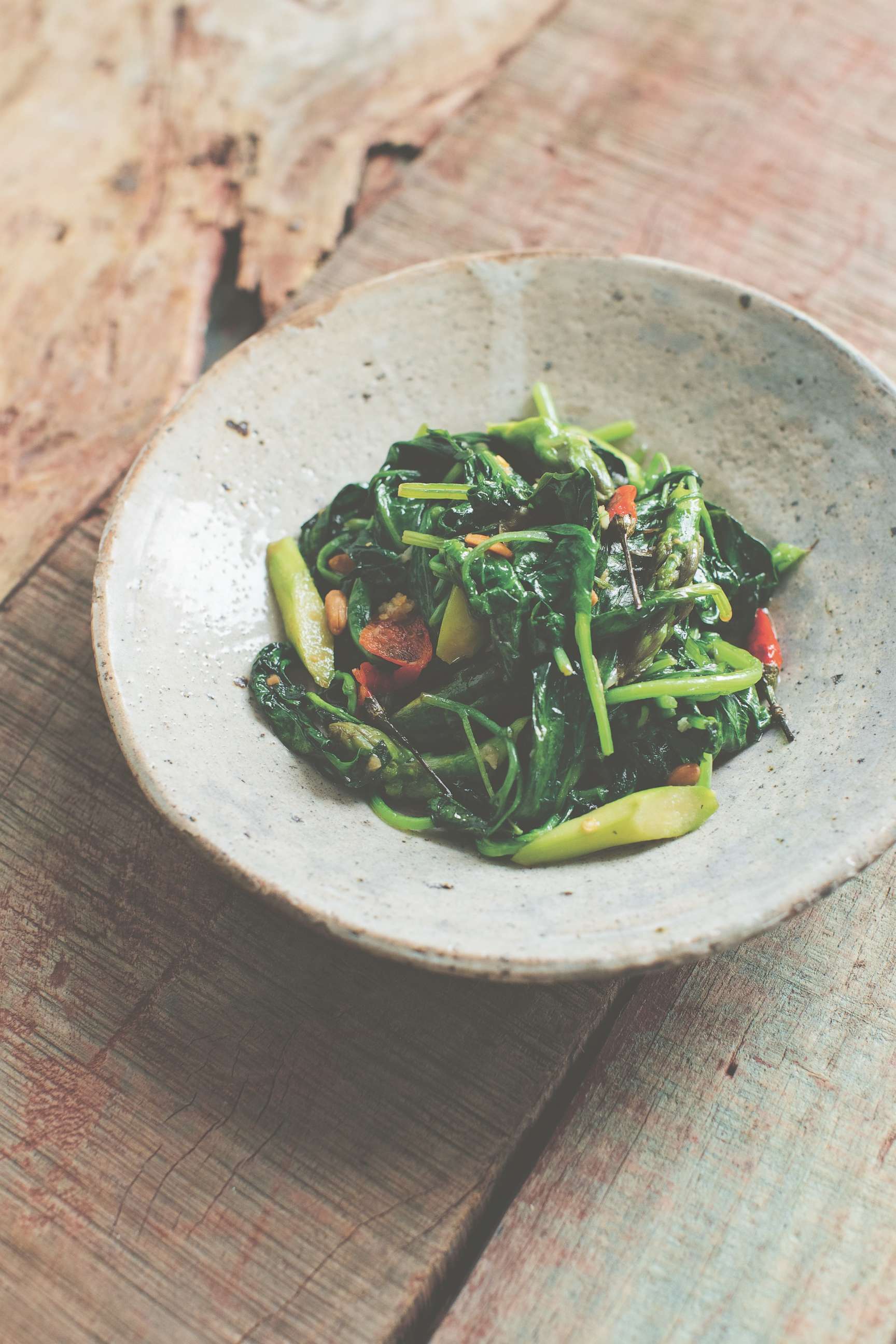
Serves: 2
"Traditionally, this dish is made using water spinach, sometimes referred to as morning glory. These tender leaves happily absorb the umami-rich flavors of the seasoning sauce. You can easily pick up water spinach in Asian supermarkets (grocery stores), but I prefer to use a selection of green vegetables based on what's in season. Use whatever works for you; just make sure to chop the vegetables into pieces that will cook evenly, as all the vegetables are stir-fried together. Fai daeng literally translates as 'red fire,' which has nothing to do with the heat level or spice of the dish, but refers instead to the huge flame that leaps out of the wok as liquid hits the smoking-hot oil. I suggest not trying to replicate this step at home if you want to keep your eyebrows."
Ingredients
2 tablespoons yellow soybean sauce 11/2 tablespoons oyster sauce (omit for a vegetarian/vegan version)
1/2 tablespoon fish sauce (or use light soy sauce for a vegetarian/vegan version)
1/2 tablespoon caster (superfine) sugar
2 tablespoons chopped garlic
1/2 teaspoon salt
9 oz mixed leafy greens, such as wild garlic leaves, spinach, mustard greens, watercress, turnip tops (cime di rapa), cabbage leaves and Brussels sprout tops
3 oz green asparagus, sliced at an angle into 1 cm (1/2 in) pieces
2 red bird's eye chillies, bruised
2 tablespoons vegetable oil
3 1/2 fl ounces/scant 1/2 cup recently boiled Chicken Stock (nahm cheua gai), or use Vegetable Stock (nahm cheua jay) for a vegetarian/vegan version
Directions
In a small bowl, combine the yellow soybean sauce, oyster sauce, fish sauce and sugar. This is your seasoning sauce. Set aside.
In a pestle and mortar, pound the garlic and salt together to a coarse paste. Set aside.
In a large bowl, layer the vegetables from softest to hardest (i.e., start with spinach and wild garlic leaves, then turnip tops, cabbage leaves and asparagus). Top with the coarse garlic paste and the bruised bird's eye chillies.
Heat the oil in a large wok over a high heat until the oil is shimmering and approaching smoking point. Upturn the bowl of greens into the wok so that the paste, chillies and harder greens make direct contact with the hot surface of the wok. Leave them to char for 1 minute before stirring, flipping and mixing the vegetables so they wilt with the heat of the wok.
Add the stock and seasoning sauce and bring the stock to a fast boil, then toss together one final time. Taste the liquid: it should be well-seasoned and umami-rich with a background sweetness. Serve immediately, allowing the liquid to pool in the serving dish.
Stir-fried Rice Noodles with Dried Prawns and Bean Sprouts: pad thai
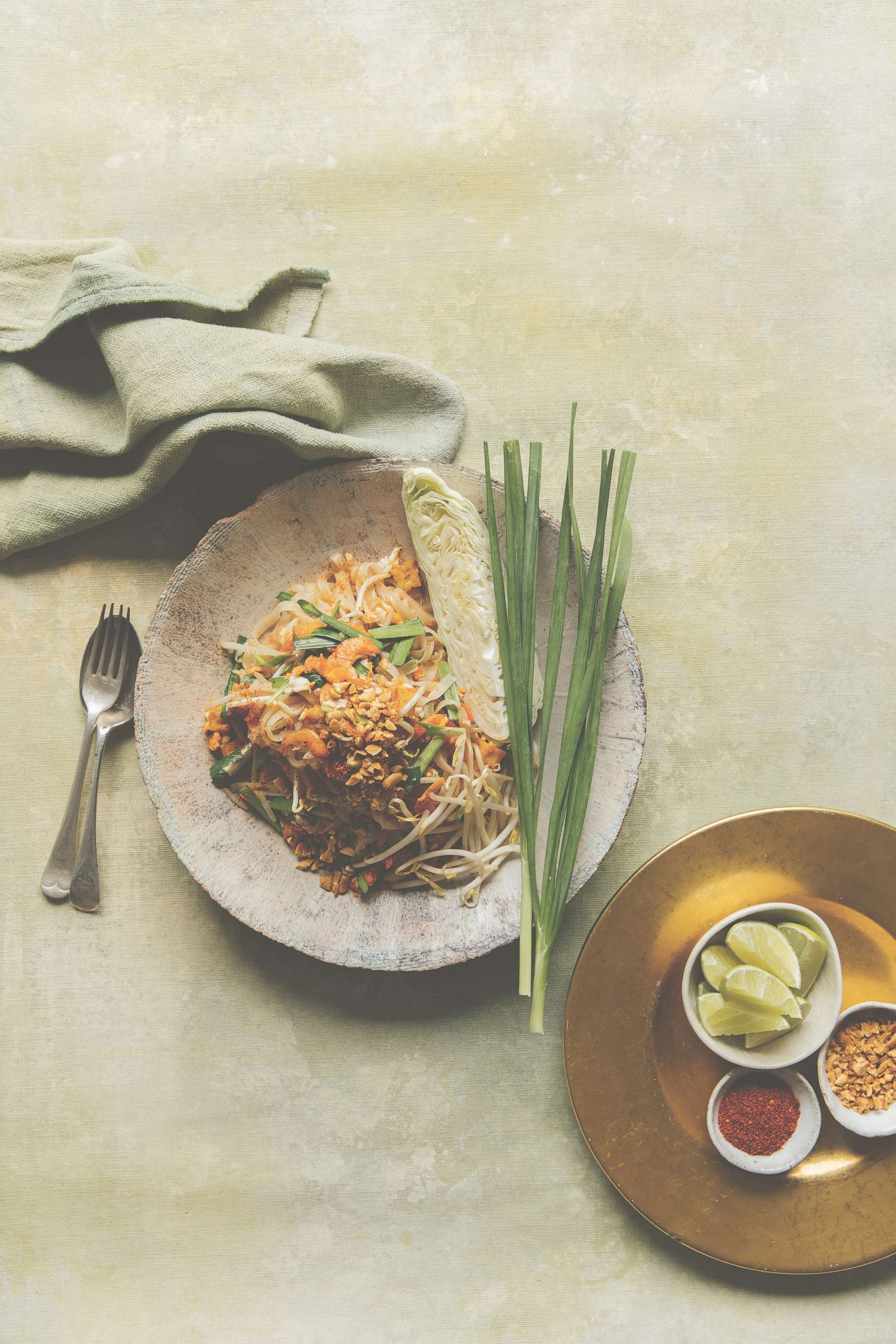
Serves: 1
"Pad thai could well be the most famous culinary export from Thailand, despite being a fairly recent addition to the Thai kitchen repertoire dating from the late 1930s. Over the years, the dish has been adapted to suit Western palates and the soul of the original dish has become lost along the way. It should come as no surprise that pad thai is a dish centred around noodles, and that the noodles should be the star of the show. In this instance, we use wide, flat rice noodles that go by the name 'rice sticks.' Look for Thai brands: you want a noodle that's 3 millimeters (1/8 inch) wide. Aside from the noodles, there is a seasoning sauce that is equally sweet, tart and salty, while other staple ingredients include dried prawns (shrimp), firm tofu, salted radish and bean sprouts. These are all available at Asian supermarkets, and I recommend buying them the first time you cook this recipe so you can see how a true pad thai should taste, before making your own adjustments and substitutes. If you wish to add proteins to the recipe, then tiger prawns, chicken and pork are all fine choices, but their appearance in pad thai is something I associate with gentrified versions of the dish that take the focus away from the noodles."
Ingredients
3 1/2 ounces dried rice noodles (rice sticks)
2 tablespoons palm or brown sugar
2 tablespoons Tamarind Water (nahm makham piak)
1 teaspoon white wine vinegar
2 tablespoons fish sauce
3 tablespoons chopped round shallot
1 1/2 tablespoons chopped garlic
1 teaspoon salt
2–3 tablespoons rendered pork fat (page 216) or vegetable oil
1 large egg
2 tablespoons firm tofu, cut into 1 cm (1/2 in) dice
2 tablespoons dried shrimp, soaked for 5 minutes until tender, then drained well
1 tablespoon shredded salted radish (otherwise called preserved turnip)
1 tablespoon roasted peanuts, coarsely crushed in a pestle and mortar
4 tablespoons (50 g/2 oz) bean sprouts, plus extra for sprinkling 2 tablespoons spring onions (scallions), cut into 3 cm (11/4 in) lengths
Lime wedges, to serve
Toasted Chilli Powder, to serve with
Directions
Soak the noodles in a large bowl of cold water for 20 minutes until they become soft and pliable, then rinse them of any starch under cold running and drain well.
In a bowl, stir together the sugar, Tamarind Water, vinegar and fish sauce until the sugar has completely dissolved. This is your pad thai seasoning sauce. Set aside.
In a pestle and mortar, pound the shallot, garlic and salt together to a coarse paste. Heat the pork fat or vegetable oil in a large wok over a medium heat, then add the paste and fry for 1 minute until fragrant and beginning to brown.
Crack the egg into the hot fat and stir so that the yolk breaks. Cook for 20–30 seconds until the egg resembles a soft omelette.
Add the drained noodles and stir to break up the egg, distributing it among the noodles. Add the seasoning sauce, along with the diced tofu, dried shrimp, shredded salted radish and crushed peanuts. Stir and toss all the ingredients well, then leave to simmer for 1 minute until almost all the sauce is absorbed and the noodles are completely tender.
Add the bean sprouts and spring onions, then toss and stir one final time so that all the ingredients are well combined and distributed. Transfer to serving plates and sprinkle with some more bean sprouts.
Grilled Beef Ribeye with 'Waterfall' Salad: neua yang nahm tok
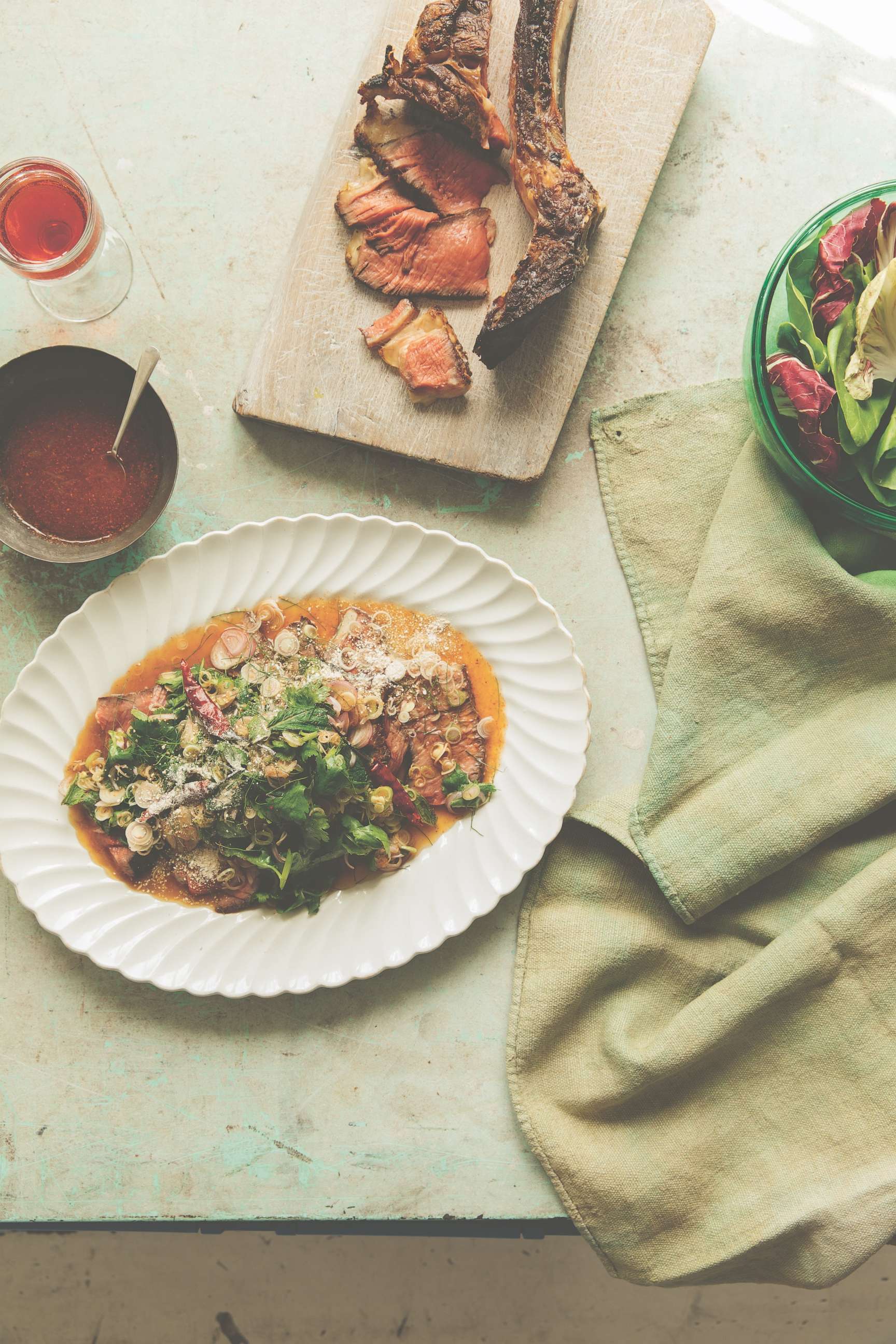
Serves: 2
"Nahm tok is an Isaan dish that has all the typical flavor characteristics of the region -- spicy, herbal, sour and salty. The name nahm tok literally translates as 'waterfall' and receives its whimsical name from the grilling meat juices dripping and falling on to the hot coals as the steak cooks. This process creates smoke and imparts a wonderful flavor. This recipe works best with dry-aged cuts with a good fat marbling, such as rib-eye and sirloin."
Ingredients
2 tablespoons fish sauce
1 tablespoon seasoning sauce
1/2 teaspoon caster (superfine) sugar
1/2 tsp ground white pepper
450 g (1 lb) ribeye steak, preferably on the bone and dry-aged for at least 21 days3 tablespoons coriander (cilantro) leaves
2 tablespoons mint leaves
1 spring onion (scallion), thinly sliced 1/2 small red onion, thinly sliced with the grain of the onion2 lemongrass stalks, root and outer husks removed, thinly sliced
2 makrut lime leaves (fresh or frozen), thinly shredded
2 dried bird's eye chillies, toasted (optional)
1 tablespoon Toasted Rice Powder
For the dressing (nahm yum)
4 tablespoons lime juice
21/2 tablespoons fish sauce
11/2 tablespoons caster (superfine) sugar
1 teaspoon Toasted Chilli Powder
Directions
For the dressing, mix together the lime juice, fish sauce, sugar and Toasted Chilli Powder in a small bowl. This should taste aggressively sour, spicy and salty. Set aside at room temperature until later.
In another small bowl, mix together the fish sauce, seasoning sauce, sugar and white pepper. Rub this all over the steak and leave to marinate for 1 hour in the refrigerator.
Prepare a charcoal grill, then cook the steak over a medium heat, turning once or twice, to give nice caramelisation and colour. I recommend cooking ribeye to medium, but cook to your preference. Leave the steak to rest for at least 5 minutes, before slicing against the grain of the meat.
In a medium bowl, mix together the coriander, mint, spring onion, red onion, lemongrass, makrut lime leaf and toasted dried chillies until combined. Add enough of the dressing to nicely coat the herbs and aromatics without drowning the leaves, then toss everything together gently to coat.
Arrange the sliced steak on a serving plate and pour over a little of the dressing to season. Arrange the herbal salad over the top of the steak and finish with a generous sprinkle of the Toasted Rice Powder to serve.
Mango with Sweet Sticky Rice: mamuang khao neow
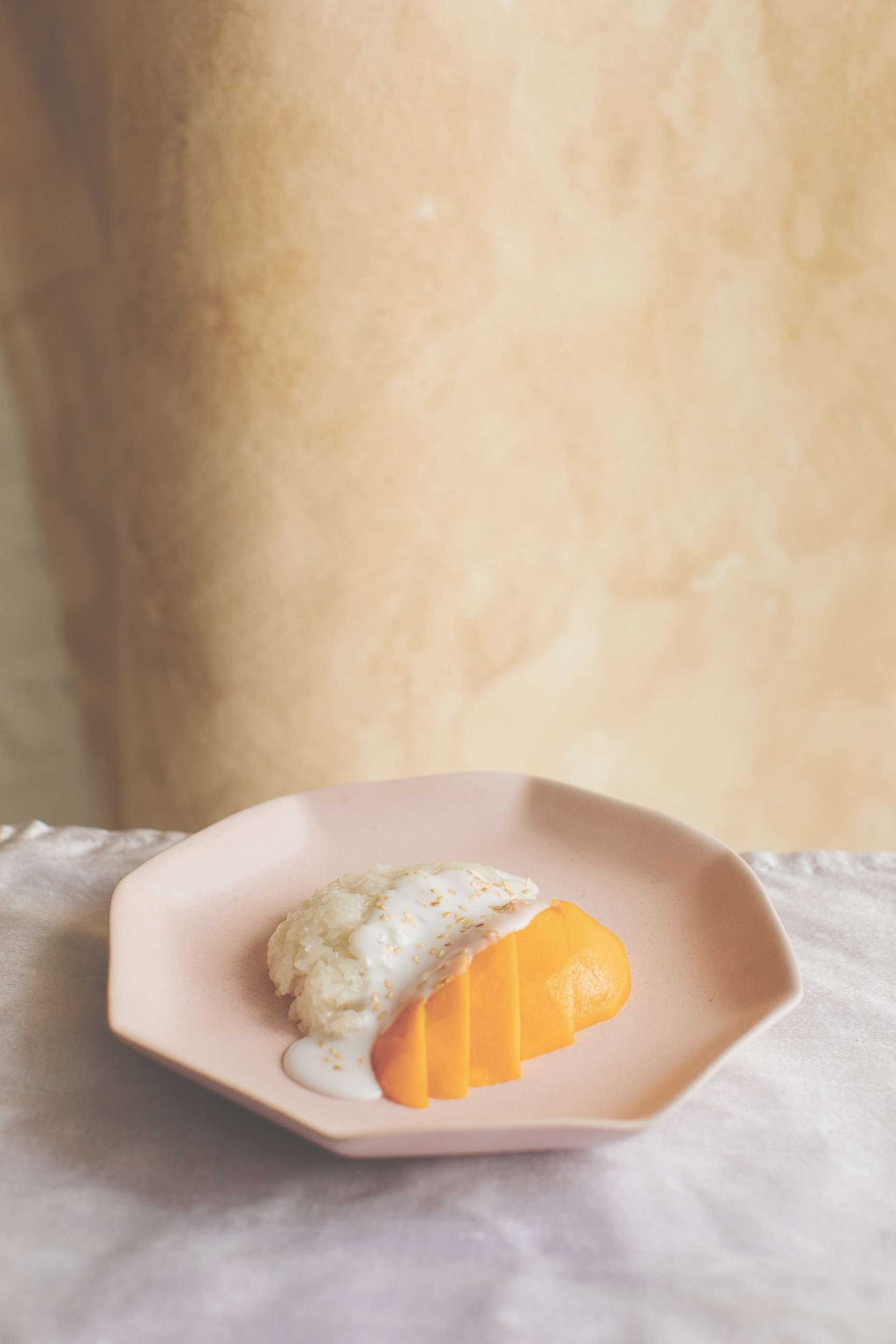
Serves: 2
"This has to be the quintessential Thai dessert beloved around the world. There aren't many components to the dish, so each ingredient should be sourced well. Thailand is blessed with incredible mangoes and the yellow ones are hard to match in flavor. I personally wait until the Indian Alphonso and Kesar mango season (May to August), as they not only have a similar look to the yellow-skinned mangoes of Thailand, but, more importantly, they have the same amazing flavour. If you want to go the extra mile, then make your own coconut cream as this recipe showcases how fantastic freshly squeezed coconut cream can taste -- creamy, rich and pure!"
Ingredinents
5 oz, or 3/4 cup sticky rice (preferably from Thailand)
7 fl oz/scant 1 cup coconut cream (the richer, heavier solids that rise to the top of the thinner milk)
1 pandan leaf, knotted (optional, but very desirable)
4 oz/1/2 cup sugar
1 teaspoon salt
1 medium ripe mango, about 10 1/2 ounces
1 teaspoon white sesame seeds, Toasted
For the sweetened thick coconut cream (gati waan)
5 fl oz/2/3 cup, coconut cream (the richer, heavier solids that rise to the top of the thinner milk)
1 pandan leaf, knotted (optional, but very desirable)
1 1/2 tablespoons caster (superfine) sugar
1/4 teaspoon salt
1/2 teaspoon rice flour
Directions
To make the sweetened thick coconut cream, put the coconut milk, pandan leaf (if using), sugar and salt into a large saucepan. Warm over a low heat for 5 minutes, stirring constantly, until the sugar has dissolved. Mix the rice flour and a little of the warm coconut cream together in a small bowl until a smooth paste forms, then stir this mixture back into the pan of sweet coconut cream. Warm for another minute, stirring constantly, until the sweet coconut cream becomes thick enough to coat the back of a spoon. Leave to cool to room temperature.
Steam the sticky rice: Meanwhile, put the coconut milk, pandan leaf, if using, sugar and salt into another saucepan and warm over a low heat for 5 minutes, stirring constantly, until the sugar has dissolved. The coconut cream will taste excessively sweet, but it needs to be in order to properly season the cooked sticky rice.
Once the sticky rice is cooked, transfer to a plastic container and pour over the second batch of prepared coconut cream. Mix well to completely incorporate the coconut cream mixture with the rice grains. It's important the rice is hot as this will allow the grains to fully absorb the liquid and become attractively glistening. Cover the surface of the sticky rice with clingfilm (plastic wrap), then cover the container with a lid. Leave to stand in a warm place for 10 minutes to allow the cream to be fully absorbed and the rice to rest.
Peel the mango with a sharp knife, then cut away the two lobes from the central stone. Cut each lobe widthways into 2.5 cm (1 in) slices.
Stir the sticky rice to loosen the grains, then divide between two shallow bowls. Place the sliced mango alongside the sticky rice, then cover the mango and sticky rice with a few tablespoons of the cooled sweetened thick coconut cream. Serve sprinkled with the toasted sesame seeds.
"Excerpted with permission from Kin Thai by John Chantarasak, published by Hardie Grant."



